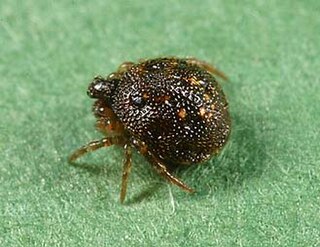
Theridiidae, also known as the tangle-web spiders, cobweb spiders and comb-footed spiders, is a large family of araneomorph spiders first described by Carl Jakob Sundevall in 1833. This diverse, globally distributed family includes over 3,000 species in 124 genera, and is the most common arthropod found in human dwellings throughout the world.

Argyrodes, also called dewdrop spiders, is a genus of comb-footed spiders that was first described by Eugène Louis Simon in 1864. They occur worldwide, and are best known for their kleptoparasitism. They can spin their own webs, but tend to invade and reside in their hosts' webs. This relationship can be commensal or even mutual if the dewdrop spider feeds on small trapped insects that are not eaten by the host. Some species can even prey upon the host.

Theridion is a genus of tangle-web spiders with a worldwide distribution. Notable species are the Hawaiian happy face spider (T. grallator), named for the iconic symbol on its abdomen, and T. nigroannulatum, one of few spider species that lives in social groups, attacking prey en masse to overwhelm them as a team.

Chrysso is a genus of comb-footed spiders that was first described by Octavius Pickard-Cambridge in 1882.

Styposis is a genus of comb-footed spiders that was first described by Eugène Louis Simon in 1894. It is a senior synonym of Cyatholipulus.

Anatea is an ant-mimicking genus of South Pacific comb-footed spiders that was first described by Lucien Berland in 1927. As of May 2020 it contains three species, found in Australia and on New Caledonia:
Paratheridula is a monotypic genus of comb-footed spiders containing the single species, Paratheridula perniciosa. The sole species was first described in 1886 under the name Theridion perniciosum. The genus was first described by Herbert Walter Levi in 1957, though it has been described under several different names, including Mysmena 4-maculata, Theridion quadrimaculatum, and Theridion arcadicum,
Uahuka is a genus of South Pacific sheet weavers endemic to the Marquesas Islands that was first described by Lucien Berland in 1935. It was transferred to the family Symphytognathidae in 1972, but the transfer was rejected in 1980.
Uapou is a monotypic genus of South Pacific sheet weaver spiders containing the single species, Uapou maculata. It was first described by Lucien Berland in 1935, and is found on Ua Pou, one of the Marquesas Islands. It was transferred to the family Symphytognathidae by H. W. Levi in 1972, but this was rejected by Brignoli in 1980. The World Spider Catalog places it in the family Linyphiidae.

Anelosimus is a cosmopolitan genus of cobweb spiders (Theridiidae), currently containing 74 species. Anelosimus is a key group in the study of sociality and its evolution in spiders. It contains species spanning the spectrum from solitary to highly social (quasisocial), with eight quasisocial species, far more than any other spider genus. Among these is the South American social species Anelosimus eximius, among the best studied social spider species.

Platnickina is a genus of comb-footed spiders that was first described by A. Ö. Koçak & M. Kemal in 2008.

Phoroncidia is a genus of comb-footed spiders that was first described by J. O. Westwood in 1835.
Philisca is a genus of South American anyphaenid sac spiders first described by Eugène Simon in 1884.
Dipoenura is a genus of comb-footed spiders that was first described by Eugène Louis Simon in 1909.

Kochiura is a genus of comb-footed spiders that was first described by Allan Frost Archer in 1950.

Pholcomma is a genus of comb-footed spiders that was first described by Tamerlan Thorell in 1869.
Proboscidula is a genus of African comb-footed spiders that was first described by F. Miller in 1970. As of June 2020 it contains two species, found in Africa: P. loricata and P. milleri.
Tekellina is a genus of comb-footed spiders that was first described by Herbert Walter Levi in 1957.
Gasteracantha flava is a species of spider described in 1849 from Chile. The spider's abdomen bears 14 spines and is yellow in color with brown or black sigilla and a strongly wrinkled ventral side. The World Spider Catalog currently treats this taxon as a spiny orb-weaver spider in the genus Gasteracantha. In 1849, H. Nicolet included it in the genus Gasteracantha along with 18 other species he described from Chile. Nicolet described G. flava as being closely allied to another species described at the same time, Gasteracantha spissa, which had the same number and shape of spines and was very similar. Subsequent authors refined Nicolet's species, and in a 1996 publication Herbert Levi wrote, "All Nicolet's species seem to belong in Phoroncidia (Theridiidae)." Levi transferred the 14-spined taxon spissa, described by Nicolet as very similar to G. flava, to the genus Phoroncidia, creating the new combination Phoroncidia spissa. However, Levi did not explicitly address G. flava, so it remains in Gasteracantha as of November 2019, though its purported sister species now belongs to Phoroncidia and no other Gasteracantha species has more than six spines.










